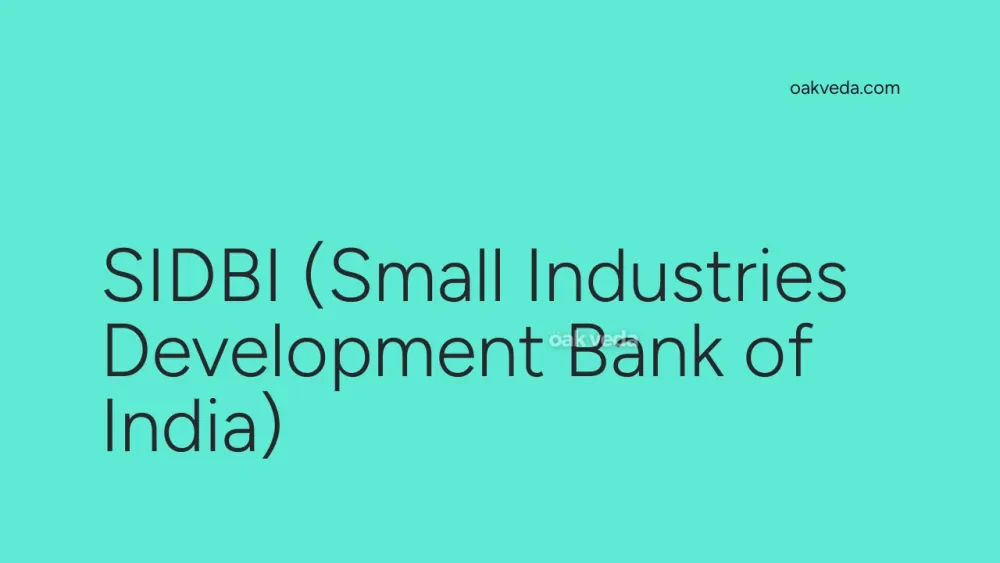
What is the Full Form of SIDBI?
The full form of SIDBI is Small Industries Development Bank of India. This financial institution plays a crucial role in the development and growth of micro, small, and medium enterprises (MSMEs) in India.
What is Small Industries Development Bank of India?
Small Industries Development Bank of India (SIDBI) is a premier development financial institution established by the Indian government to promote, finance, and develop the MSME sector. Created by an Act of Parliament on April 2, 1990, SIDBI operates under the Department of Financial Services, Government of India.
Origin and Development of SIDBI
SIDBI was founded with the primary objective of addressing the financial needs of the small-scale industries sector. Over the years, it has evolved to become the principal financial institution for the MSME sector in India. Its headquarters are located in Lucknow, with branches spread across the country to ensure widespread support for small businesses.
How does SIDBI work?
SIDBI operates through various financial mechanisms to support the MSME sector:
- Refinancing: SIDBI provides refinancing to banks and other financial institutions that lend to MSMEs.
- Direct Lending: The bank offers direct loans to MSMEs for various purposes, including expansion and modernization.
- Micro-finance Support: Through the SIDBI Foundation for Micro Credit, it promotes microfinance institutions.
- Promotional and Developmental Initiatives: SIDBI undertakes various programs to support rural industries and overall economic development.
Functions of SIDBI
The primary functions of SIDBI include:
- Providing financial assistance to MSMEs through various schemes
- Coordinating the functions of institutions engaged in similar activities
- Promoting entrepreneurship and self-employment opportunities
- Extending support for technology upgradation and modernization of MSMEs
- Offering advisory and consultancy services to small industries
Applications of SIDBI
SIDBI's applications extend to various aspects of MSME development:
- Credit Delivery: Ensuring timely and adequate credit flow to MSMEs
- Skill Development: Supporting initiatives for enhancing entrepreneurial and technical skills
- Cluster Development: Promoting industrial clusters for efficient growth of MSMEs
- Sustainable Finance: Encouraging green and sustainable practices in the MSME sector
- Women Entrepreneurship: Special focus on promoting and supporting women-led enterprises
Features of SIDBI
Key features that distinguish SIDBI include:
- Statutory Role: SIDBI is one of the four All India Financial Institutions governed by the Reserve Bank of India
- Comprehensive Support: Offers a wide range of financial and non-financial services to MSMEs
- Policy Advocacy: Plays a crucial role in shaping policies for MSME development
- Innovation Focus: Promotes innovative financing methods and products for MSMEs
- Collaborative Approach: Works in partnership with various stakeholders, including government agencies, banks, and industry associations
Benefits of SIDBI
The existence and operations of SIDBI bring numerous benefits to the Indian economy:
- MSME Growth: Facilitates the expansion and modernization of the MSME sector
- Employment Generation: Supports job creation through MSME development
- Financial Inclusion: Enhances access to finance for small businesses and entrepreneurs
- Economic Development: Contributes to overall economic growth by strengthening the MSME backbone
- Regional Balance: Promotes balanced regional development through targeted interventions
Limitations or Challenges of SIDBI
Despite its significant role, SIDBI faces certain challenges:
- Reaching the Unorganized Sector: Difficulty in extending support to informal MSMEs
- Risk Management: Balancing financial support with prudent risk management
- Technological Adoption: Keeping pace with rapid technological changes in the financial sector
- Resource Mobilization: Ensuring adequate funds for the growing needs of the MSME sector
- Regulatory Compliance: Adapting to evolving regulatory frameworks while maintaining operational efficiency
Future Developments in SIDBI's Operations
Looking ahead, SIDBI is poised for several developments:
- Digital Transformation: Enhancing digital platforms for easier access to MSME finance
- Sustainable Finance: Increased focus on green financing and sustainable business practices
- Global Partnerships: Collaborating with international institutions for knowledge and resource sharing
- Innovative Financial Products: Developing new financial instruments tailored to emerging MSME needs
- Data Analytics: Leveraging big data for better decision-making and risk assessment
FAQs on SIDBI Full Form
-
What is the primary objective of SIDBI? SIDBI's main objective is to promote, finance, and develop the MSME sector in India.
-
When was SIDBI established? SIDBI was established on April 2, 1990, through an Act of Parliament.
-
Is SIDBI a government organization? Yes, SIDBI is a government-owned financial institution operating under the Department of Financial Services.
-
How does SIDBI support microfinance? SIDBI supports microfinance through the SIDBI Foundation for Micro Credit and by promoting microfinance institutions.
-
Can individual entrepreneurs apply for loans from SIDBI? While SIDBI primarily works through other financial institutions, it also offers direct lending to MSMEs in certain cases.
In conclusion, the Small Industries Development Bank of India (SIDBI) plays a vital role in nurturing and supporting the MSME sector, which is crucial for India's economic growth. Through its diverse range of financial and developmental services, SIDBI continues to be a cornerstone in the nation's efforts to create a robust and thriving small business ecosystem.
You may be interested in:

